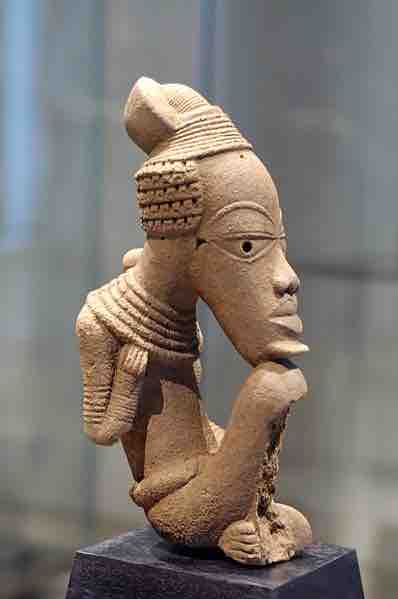The earliest identified Nigerian culture is the Nok culture, which thrived between 1500 BCE and 200 CE on the Jos Plateau in northeastern Nigeria. Information is lacking from the first millennium BCE following the Nok ascendancy. However, by the second millennium BCE, there was active trade from Ancient Egypt via Nubia through the Sahara to the forest with the savanna people acting as intermediaries in exchanges of various goods. Reasons for the Nok's sudden disappearance remains unknown.
Nok and Lydenburg Terra Cotta Sculptures
Ancient terra cotta sculptures in the form of human bodies or heads have been found in several areas of sub-Saharan Africa, providing glimpses into the cultures that existed in the region. Two of the best examples are from the Nok culture in present-day Nigeria and from an ancient culture living near the present-day town of Lydenburg, South Africa.
Nok
Based on similarities seen in artwork, it has been suggested that the Nok culture evolved into the later Yoruba culture of Ife. One such example can be seen in a Nok sculpture of a woman, which bears a striking resemblance to an early twentieth-century sculpture of a king and queen mother by the Yoruba artist Olowe of Ise. The Nok culture was considered to be the earliest sub-Saharan producer of life-sized terra cotta sculptures.
Female figurine
Terra cotta. 48 cm tall. Nok culture. c. 515-1215 CE.
The first scattered fragments were discovered on the Jos Plateau during a tin mining expedition in 1928. The terra cotta figures are hollow, and while some include plant and animal motifs, the most well known are of human heads and bodies that often reach life-sized proportions. These human sculptures contain very detailed and stylized features, abundant jewelry, and varied postures. Some even illustrate physical ailments, disease, or facial paralysis. While their function is largely unknown, theories include use as ancestor portrayal, grave markers, finials for roofs of buildings (suggested by their dome-shaped bases), or charms to protect against crop failure, infertility, or illness.

Nok sculpture
Nok sculptures may have been used as grave markers, charms or portrayals of ancestors. Terra cotta. Sixth century BCE-sixth century CE. Nigeria
Researchers have suggested that Nok ceramics were most likely shaped by hand from coarse-grained clay and then subtractively sculpted in a manner that suggests an influence from wood carving. After some drying, the sculptures were covered with slip and polished to produce a smooth, glossy surface. The firing process most likely resembled that used today in Nigeria, in which the sculptures are covered with grass, twigs, and leaves and burned for several hours.
Lydenburg
Lydenburg, a town in Mpumalanga, South Africa, is also known for the discovery of some of the earliest forms of African sculpture. The Lydenburg Heads (400-500 CE) are terra cotta sculptures similar to those of the Nok culture, taking the form of human heads. Found in the area in the late 1950s, their function is still unknown, although they likely served a ritualistic purposes as masks, ornamentation, or part of ceremonial regalia.
Lyndenburg Head
The Lydenburg Heads are the earliest known examples of African sculpture in Southern Africa. Two of the heads are large enough to have been worn as ceremonial helmet masks. The other five smaller heads have a hole on either side of the neck, by which they could have been attached to a pole or costume during a performance. One of the small heads has an animal-like nose and mouth, which would have been a symbolic importance to the makers of the heads.
Since their discovery, these heads have come to symbolize African art in multiple awards. The image of the Lydenburg head can be seen both on the badge given by the South African Order of Ikhamanga, where they represent achievement in the arts, as well as in the Golden Horn trophy of the South African Film and Television Awards (SAFTA), where they signify excellence in visual creative arts, performance and drama.

The Order of Ikhamanga
An image of the Order of Ikhamanga, where the Lydenburg head can be seen in the center.